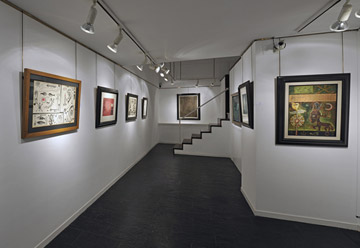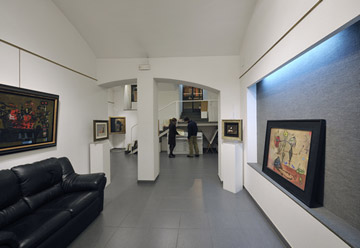- Amat, Frederic
- Amat, Gabriel
- Arranz Bravo
- Arroyo
- Barbara
- Barcelo
- Bartolozzi
- Bea
- Becquer
- Benet
- Bird
- Bores
- Brinkmann
- Brossa
- Cardenas
- Carral
- Casas
- Castillo
- Chancho
- Cisquella
- Clave
- Corbero
- Corneille
- Croft
- Cuixart
- Domingo
- Fabres
- Farreras
- Feito
- Fenosa
- Forteza
- Genovart
- Gimeno
- Gonzalez
- Gonzalo
- Graner
- Granyer
- Grau
- Grau Sala
- Gudiol
- Guinovart
- Hernandez Mompo
- Hernandez Pijuan
- Jorn, Asger
- Junyent, Oleguer
- Lam
- Llena
- Lloveras
- Lopez Ramon
- Marin
- Marsans
- Marsillach
- Marti Alsina
- Matilla
- Meifren
- Menchu Gal
- Meseguer
- Mir
- Mira
- Miro
- Moore
- Moragas
- Munoz
- Noland
- Olive
- Palazuelo
- Palencia
- Pazos
- Perejaume
- Perez Villalta
- Picasso
- Plantalech
- Plasencia
- Plensa
- Ponç
- Puig
- Rafols Casamada
- Ramis
- Rasero
- Rebull
- Riera i Arago
- Rivera
- Roca Sastre
- Roig
- Roig Soler
- Rossell
- Rueda
- Saura
- Serra
- Sicilia
- Solano
- Subirachs
- Sunyer
- Tamayo
- Tapies
- Tharrats
- Togores
- Torres Garcia
- Ubeda
- Ucles
- Valdes
- Valls
- Vedova
- Viladecans
- Vilagrasa
- Villa
- Zao Wou-ki
Artists +
Hours
Rueda
Gerardo Rueda (1926-1996) embarked on his artistic journey with studies in classical painting, and in 1949, he exhibited for the first time in the Spanish capital. In the early 1950s, he presented his first collages and abstract drawings.
His first solo exhibitions took place in 1958 in Barcelona, at the Jardín Galleries and the Green Gallery of Ángel Marsé. From then on, he participated in more than 200 group exhibitions, with one of the most notable being the "Muestra de Arte Nuevo-MAN 64" at the X Salón de Mayo in Barcelona, where he won the Hermanos Serra Prize in 1966.
Rueda participated in over 60 individual shows in some of the world’s most prestigious galleries. In 1960, he represented Spain at the Venice Biennale. In 1995, he was appointed an academic at the Academy of Fine Arts of San Fernando. In 1996, he held an exhibition at IVAM in Valencia, which toured various American museums and concluded at the Reina Sofía National Art Center Museum.
He created numerous sculptures, reliefs, and monumental commissions, such as the mural relief for the Outdoor Sculpture Museum on the Castellana (Madrid), the Stained Glass Windows of Cuenca Cathedral (1989-1992), and the entrance doors to the Spanish Pavilion at the Seville Universal Exhibition (1992).
In his artistic trajectory, Gerardo Rueda embraced Cubist concepts and evolved towards constructivist abstraction, characterized by order and balance. He was one of the pioneers in introducing informalism to Spain. Alongside Fernando Zóbel, he co-founded the Museum of Abstract Art in Cuenca.
Rueda belonged to the generation of Torner, Zóbel, and Mompó, collectively known as the "generation of silence." In his early works, his compositions were harmonious, dominated by light colors, but later, he transitioned to pieces with more depth in color. Notably, his white and gray paintings are worth mentioning.
From the seventies onwards, he began to use materials such as wood, paper, and metal. Later, he was influenced by pop art and incorporated everyday objects (ready-made) into his artistic work, such as a washboard or a doorknob.
His works can be found in museums and collections worldwide, including the Reina Sofía National Art Center Museum (MNCARS) in Madrid, The British Museum in London, the Fine Arts Museum of San Francisco, the Frederick R. Weisman Museum of Art in Los Angeles, the Fundación Juan March in Madrid, and numerous others.





